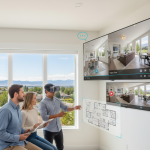Overview of Modular Homes
Modular housing, fundamentally, involves prefabricated sections constructed in a factory setting and then transported to the final site for assembly. This method ensures uniformity and precision, offering seamless integration into various architectural designs. Construction process is typically swifter than traditional methods due to streamlined production in controlled environments. This efficiency often results in completion timelines that are significantly shorter, potentially reducing costs.
When comparing modular homes to traditional construction methods, notable distinctions emerge. First, modular housing allows for consistent quality through factory production, often meeting higher precision standards. In contrast, traditional building relies heavily on varying onsite conditions and local craftsmanship, leading to potential inconsistencies.
Also read : Vallourec stock overview: key insights into shareholding trends
Furthermore, modular homes can be customized to suit specific needs without extensive onsite modifications, while traditional homes might require considerable time and craftsmanship adjustments. Key advantages of modular housing also include reduced waste and less environmental disruption, owing to prefabrication processes. These benefits render modular homes a compelling choice for sustainable and efficient building practices.
Ultimately, both methods possess unique merits, yet recent shifts towards sustainability and efficiency may drive further adoption of modular housing solutions.
Also to read : Unlocking Coastal Property Potential in the UK: A Comprehensive Future Investment Guide
Case Studies of Successful Modular Housing Projects
Modular housing success stories provide insightful perspectives on this innovative construction approach. In the UK, numerous projects demonstrate how modular homes can meet various housing needs effectively. The Y:Cube project in South London exemplifies this by delivering affordable accommodation for single occupants. Y:Cube’s design features prefabricated units constructed in a factory setting, reducing costs and assembly time. Residents benefit from lower rents due to minimized construction expenses.
These success stories highlight the importance of modular housing in tackling housing shortages. In particular, the Sussex Healthcare project used modular construction to expand care facilities quickly and efficiently. The project confirms how speedy deployment and cost-effectiveness can address urgent housing demands.
A key factor in these successes is the collaboration between developers, local governments, and communities. By learning from these examples, future modular projects can replicate strategies that streamline processes and improve outcomes. Such case studies show the potential of modular housing solutions to offer sustainable and economical alternatives to traditional construction methods. Ultimately, these real-world examples pave the way for widespread adoption and acceptance of modular homes in addressing the contemporary housing crisis.
Financial Benefits of Modular Homes
Modular homes often provide significant cost-effectiveness compared to traditional construction. Prefabrication allows for bulk purchasing of materials, reducing expenses. Additionally, the sped-up construction process can minimize labour costs. These elements contribute to making modular homes more affordable, especially beneficial in urban areas where housing prices are typically higher.
An economic analysis indicates that savings from modular construction often translate into more accessible housing opportunities. With shorter timelines, holding costs decrease, thus positively impacting overall housing affordability. Notably, this approach benefits rural communities by offering quality housing solutions without incurring the typically high construction costs associated with remote locations.
Several case studies highlight the return on investment (ROI) for modular projects. For instance, projects in urban centers show that reduced timelines lead to quicker occupation, generating faster rental income. This can enhance the attractiveness of modular homes for developers by promising a quicker financial return.
In summary, modular homes offer economic advantages that address uncertain market dynamics and rising urban housing costs. By significantly cutting construction expenses, they prove to be a strategic choice for expanding affordable housing options, making them a compelling alternative in both urban and rural settings.
Regulatory Considerations for Modular Housing
Navigating the regulatory landscape for modular housing in the UK can present unique challenges. Modular homes must adhere to existing housing regulations and building codes, ensuring structural integrity and safety. Notably, these homes also require planning permissions, aligning with local zoning laws and community standards.
Despite their sustainable advantages, modular homes often face hurdles within the regulatory framework. For instance, differing regional interpretations of construction standards can complicate approval processes. Additionally, modular systems might not seamlessly fit within traditional categorizations of housing, leading to potential delays.
Recognising these challenges, there is growing dialogue surrounding potential regulatory reforms. Simplifying procedures and creating modular-specific guidelines could facilitate broader adoption. Streamlined processes would likely encourage innovation and improve housing availability.
Strategically revising regulations could also address concerns about quality, ensuring consistency across all modular projects. By adapting policies that acknowledge the unique benefits of modular construction, the UK can support the advancement of modular housing solutions. As modular homes gain popularity, proactive adjustments in the regulatory framework may serve as a catalyst for industry growth, enabling it to meet evolving housing demands effectively.
Environmental Benefits of Modular Homes
Modular homes present notable sustainability advantages due to their efficient production processes. Prefabrication occurs in controlled settings, significantly reducing the ecological impact compared to traditional construction. This method limits waste generation and resource consumption, as precise measurements and standardised processes ensure material efficiency. Moreover, transportation emissions decrease since fewer trips are necessary to transport materials and modules when compared to conventional construction methods.
Energy efficiency in modular homes is another critical benefit. Designs often incorporate sustainability features, such as high-grade insulation, energy-efficient windows, and solar panels, to optimise thermal performance. Furthermore, the accuracy of factory-based production allows for tighter seals and enhanced airtightness, reducing energy leakage. Consequently, modular homes often require less energy for heating and cooling, leading to lower utility bills for occupants and a smaller carbon footprint overall.
In comparison to conventional housing, the environmental impact of modular homes is substantially mitigated. Traditional methods can lead to increased waste, higher emissions, and greater resource consumption due to uncontrolled onsite conditions. In summary, modular homes demonstrate an environmentally friendly alternative by harmonising construction precision with sustainable practices, offering a path towards a greener future.
Comparisons with Traditional Housing Solutions
When evaluating modular vs traditional housing, several distinctions arise in construction methods and outcomes. Modular housing typically involves factory-built sections, ensuring consistent quality through controlled environments. This leads to quicker assembly times compared to traditional builds, which depend on on-site work subject to varying conditions. Consequently, modular homes often experience fewer delays due to weather or supply chain disruptions.
In terms of cost, modular housing can offer significant savings. Factory processes allow for bulk purchasing and reduced labour costs, providing an economic edge over traditional methods. However, the perception of modular homes sometimes encounters skepticism, linked to misconceptions about prefab quality or design limitations. Yet, modern modular homes can be sleek and sophisticated, rivaling their conventionally constructed counterparts.
From an environmental perspective, modular construction’s reduced waste and emissions appeal to those prioritizing sustainability. Traditional methods, while adaptable, often result in higher ecological impact due to site-specific challenges and waste generation. In sum, modular homes serve as a pragmatic solution amidst the housing crisis, offering a balance of efficiency and sustainability often not matched by traditional builds.
Innovative Solutions and Future Prospects
The future of housing is increasingly interwoven with the advancement of modular construction. Innovative technologies like 3D printing and digital design tools are poised to revolutionize how modular homes are conceived and built, fostering new levels of customization and design flexibility. This technological evolution is set to address the housing crisis solutions within the UK, providing efficient and scalable alternatives to traditional building methods.
Upcoming trends in modular innovation also include the integration of smart home technologies, enhancing energy management and occupant connectivity. Such advancements not only promise enhanced living standards but also align with sustainability goals, making modular homes a preferred choice for future developments.
Predictions indicate that modular homes will play a critical role in meeting diverse housing demands, particularly as urban populations grow and environmental concerns intensify. Their adaptability, combined with cost-effectiveness, positions them as a viable solution to rapidly changing housing needs. As these homes continue to evolve, their capability to incorporate renewable energy sources and zero-waste designs emphasizes their potential in shaping the future housing landscape in the UK. The modular approach heralds a transition towards more sustainable, resilient, and dynamic living environments.






